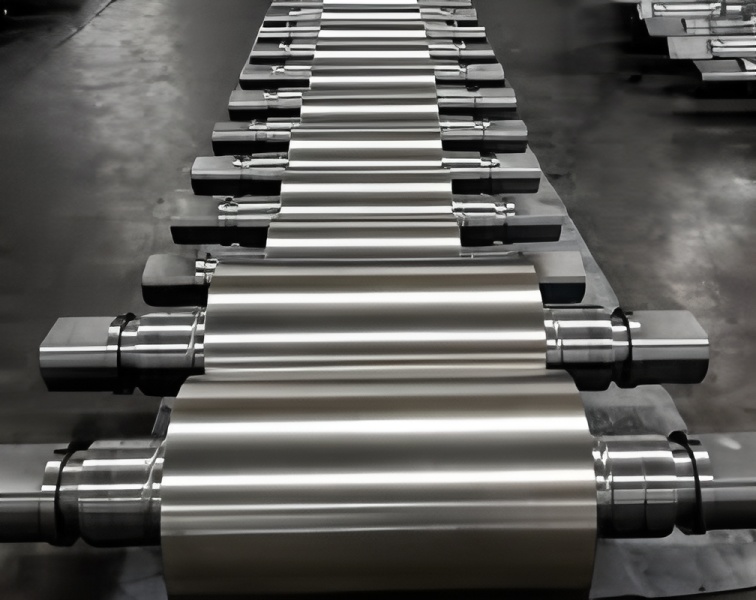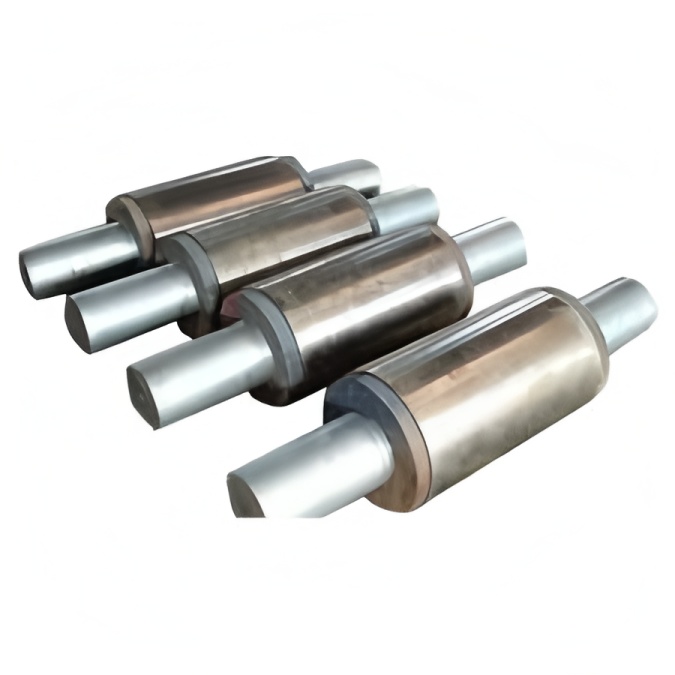Description: Professional manufacturer of rolling mill rolls with over 20 years of production experience.
Keywords: Rolling mill rolls, material selection, types of rolls
Selection of Materials for Rolling Mill Rolls
Alloy Chilled Cast Iron Roll
Alloy chilled cast iron rolls (or roll rings) are produced by leveraging the supercooling of molten iron and mold surface quenching, with added Ni, Cr, and Mo alloying elements. The working layer matrix contains almost no free graphite, providing high hardness and excellent wear resistance.
This material allows large-scale roll production via static compound casting, combining a high-hardness roll body with a high-strength, tough roll neck, delivering good thermal stability and accident resistance.
Applications: Small bar and wire rod mills, finishing stands of narrow strip mills, stretch-reducing roll rings for seamless steel pipe mills, three-roll medium plate mills, and hot-rolled stacked sheet mills.
Alloy Indefinite Chilled Cast Iron Roll
These rolls differ from standard chilled iron rolls due to fine graphite precipitates in the working layer. Graphite is uniformly dispersed, increasing in size and quantity with depth. Alloying elements like Mn, Cr, Ni, and Mo enhance spalling resistance, thermal crack resistance, and wear resistance, with minimal hardness drop. Fine graphite pores also improve roll bite.
Applications: Bar, wire rod, and section steel mills (intermediate and finishing stands), reducing roll rings for seamless pipe mills.
Alloy Ductile Iron Roll
These rolls feature spherical graphite in the matrix. Adjusting Ni, Cr, Mo, and heat treatment produces various grades: ordinary ductile iron, large alloy ductile iron, pearlitic ductile iron, and acicular ductile iron. They offer good strength, high-temperature performance, accident resistance, and minimal hardness gradient.
Applications: Roughing and intermediate stands in bar, wire, and section steel mills; vertical rolls for rail beam edge rolling.
High Nickel Chromium Indefinite Chilled Cast Iron Roll
Produced via centrifugal or full flush methods, these high-performance rolls contain increased Ni, Cr, and Mo for high microhardness carbides and matrix. Special heat treatment ensures a uniform, dense structure with minimal hardness drop. Free graphite improves wear, thermal crack, spalling, and indentation resistance.
The outer layer thickness is customizable; the core uses nodular gray iron or high-strength ductile iron for strength and toughness. Sufficient water cooling is essential during use.
Applications: Hot strip continuous rolling (later finishing stands), wide/medium plate mills (roughing and finishing), hot zone temper mill work rolls, backup rolls, and cross-cutting pass rolls.

High Chromium Composite Cast Roll
The working layer contains 6–22% Cr alloy; the core is high-strength ductile iron. Depending on carbon content, these are classified as high-chromium cast steel or cast iron rolls. High chromium forms M₇C₃ carbides with high hardness, good toughness, and wear resistance. The alloy-rich matrix, after heat treatment, offers good high-temperature mechanical properties.
For hot strip rolling, choose between high-chromium cast steel or cast iron based on shift count and cooling conditions. These rolls are also suitable for cold rolling, skin pass mill work rolls, and roll rings.
Applications: Roughing work rolls for hot strip mills, cold strip mill work rolls, medium/wide plate mill work rolls, bar/wire mill rolls, and seamless pipe straightener rolls.
Alloy Cast Steel Roll
Made from high-quality electric furnace and refined steel, advanced casting, and heat treatment provide high strength, thermal crack resistance, toughness, and wear resistance.
Applications: Roughing mills for squares/slabs, roughing/intermediate stands in section steel mills, hot strip continuous mills, descaling vertical rolls, two-roughing mills for plates, hot-rolled narrow strip backup rolls.
Semi-Steel Roll
Includes solid rolls, composite rolls, and sleeves. Made from high-carbon steel with Mo, Cr, Ni, and trace alloys, plus special heat treatment. Offers high wear resistance, toughness, thermal crack resistance, and minimal hardness drop.
Applications: Hot strip mills (roughing, early finishing, vertical rolls); section steel, rail beam, and bar mills (roughing, intermediate, pre-finishing); roll rings/sleeves for universal and cantilever mills.
Graphite Cast Steel Roll
Similar to semi-steel but with some graphite in the structure, improving thermal crack and oxidation resistance. Suitable for preliminary or rough rolling.
Applications: Hot strip mills, two-roughing reversible mills for medium/wide plates, blooming mills, billet continuous mills, section steel/rail beam mills (especially deep-groove rolls), roughing stands in hot strip continuous mills.
Composite Cast Steel Backup Roll
Made via composite casting, the outer layer with Ni, Cr, Mo (and special heat treatment) has a microstructure of tempered sorbitic, bainitic, and fine carbides. The core and neck use low-carbon or low-alloy steel for high wear/spalling resistance and toughness.
Applications: Roughing/finishing stands in cold/hot strip mills, medium/heavy plate and wide plate mills, Steckel mills.
High-Speed Steel Composite Roll
Produced by vertical centrifugal casting. The outer layer is high-speed steel with high hardness and elevated temperature wear resistance; the core is high-strength ductile iron. Combines high wear resistance and toughness.
High alloy content and special heat treatment produce an outer layer with MC, M₂C, and M₆C carbides on a martensitic matrix, with minimal hardness drop. Alloy content and secondary hardening provide high-temperature wear resistance—surface hardness remains stable up to 550°C, with 3–5× the wear resistance of high-Ni-Cr indefinite chilled or high-Cr iron rolls.
Applications: Finishing stand work rolls for hot/cold strip mills; roll rings/sleeves for bar, wire, and universal H-beam mills.
Forged Steel Cold Roll
Includes cold-rolled work and backup rolls. Made using advanced smelting (electric arc furnace), refining (ESR, ladle), and forging (3150t press) for high metallurgical quality. Computer-controlled heat treatment ensures consistent hardness and hardened depth (>30 mm). Processes include preparatory heat treatment, induction hardening (continuous or overall), cryogenic treatment, and tempering for high wear resistance, toughness, and accident resistance. Benefits: high rolling capacity, low energy use, long life.
Forged Steel Hot Roll
Made from high-quality alloy forged steel billets. Special heat treatment provides satisfactory hardness and hardened depth, balancing wear resistance with strength, toughness, and bite. Used in hot strip and profile rolling mills.


